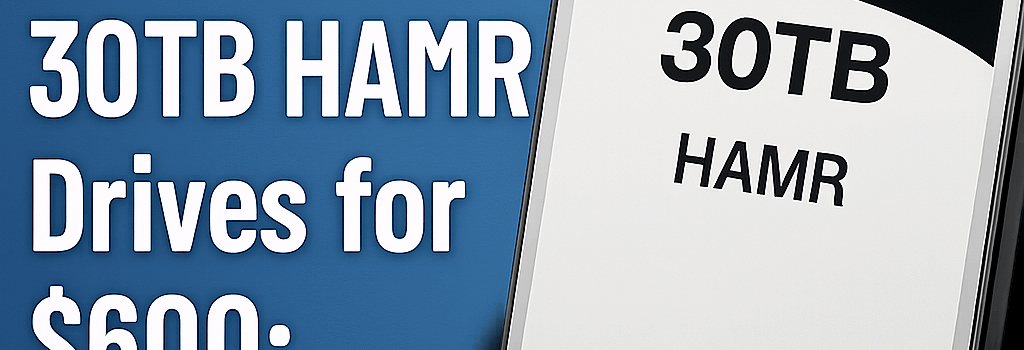Seagate Launches 30TB HAMR Drives for $600: Tech Overview

After more than two decades of research and development, Seagate has opened sales of its first consumer- and SMB-accessible heat-assisted magnetic recording (HAMR) hard drives. The new 30 TB IronWolf Pro and Exos M models, priced at $600 each, bring unprecedented areal densities and cost-effective bulk storage to IT administrators, NAS users, and AI practitioners alike.
From Lab to Server Rack: The Evolution of HAMR
Seagate first announced its intent to commercialize HAMR in the early 2000s. The core innovation involves an integrated solid-state laser diode in the drive head that heats a microscopic spot on the platter above its Curie temperature. This temporary heating—lasting less than a nanosecond—allows bits to be written at sub-10 nm scales before the platter cools and the high-coercivity grains lock in data. Over successive prototype generations, Seagate refined:
- Laser integration: From bench-top optics to sub–3 mm diode modules embedded in the read/write head.
- Media engineering: Transitioning from FePt alloy coatings to multilayer granular media that withstand repeated thermal cycling.
- Servo and firmware: Real-time thermal modeling to maintain head-to-media spacing below 4 nm.
Drive Specifications and Platform Architecture
Both the IronWolf Pro and Exos M series are built on Seagate’s Mosaic 3+ platform, delivering 3 TB per platter across ten 3.5″ disks. Key specs include:
- Capacity: 28 TB ($570) and 30 TB ($600) per 7200 RPM drive.
- Interface: SATA III (6 Gb/s) or SAS (12 Gb/s) options.
- Cache: 512 MB DDR4 onboard buffer.
- Power Consumption: ~9.8 W (read/write), ~6.8 W (idle).
- MTBF: 2 M hours, workload rated up to 550 TB/year.
Unlike shingled magnetic recording (SMR), these drives use conventional magnetic recording (CMR) enhanced by HAMR, ensuring high random-write performance and broad compatibility with RAID controllers.
Deep Dive into HAMR Technology
At the heart of HAMR is the interplay between thermal physics and nanoscale magnetism. A continuous-wave laser with a 1.48 µm wavelength locally heats a 40 nm spot. As the spot cools from above 450 °C, high-coercivity grains (~8 M A/m) solidify in a stable magnetic orientation. Challenges overcome include:
- Heat dissipation: Thermal cross-talk mitigation between adjacent tracks via low-conductivity bonding layers.
- Head durability: Protecting the laser diode and near-field transducer from mechanical shock.
- Media wear: Ensuring >600 PB of endurance under heavy enterprise workloads.
Economic Impact and TCO in Data Centers
At $20 per terabyte, these drives undercut high-capacity SSDs (often >$100/TB) by 5×. For hyperscale and edge data centers, savings compound through:
- Power efficiency: Lower watt/TB compared to flash arrays.
- Cooling and floor space: Higher density reduces rack count and PUE (Power Usage Effectiveness).
- Five-year TCO: Integrated cost analysis shows up to 30% lower TCO vs all-flash tiers for cold and warm data.
Market Landscape and Future Roadmap
Seagate isn’t alone. Competitors are racing to HAMR and advanced SMR:
- Western Digital: Plans first 30–32 TB HAMR drives in 2027, while offering 32 TB ePMR/SMR models this year.
- Toshiba: Sampling HAMR prototypes in 2025, with production targets TBD.
- Seagate roadmap: 36–40 TB HAMR drives for hyperscale customers in late 2025 and 2026.
“HAMR is the only proven path to >30 TB in a 3.5-inch form factor,” says Dr. Priya Patel, a storage analyst at IDC. “It balances density, performance, and cost in ways SMR and PMR alone cannot.”
Expert Insights
- Reliability: Enterprise customers report zero head crashes in over 100 PB of aggregated HAMR writes during beta trials.
- Adoption: Major cloud providers are integrating 30 TB drives into cold-storage tiers, citing simplified data migration and lower operational overhead.